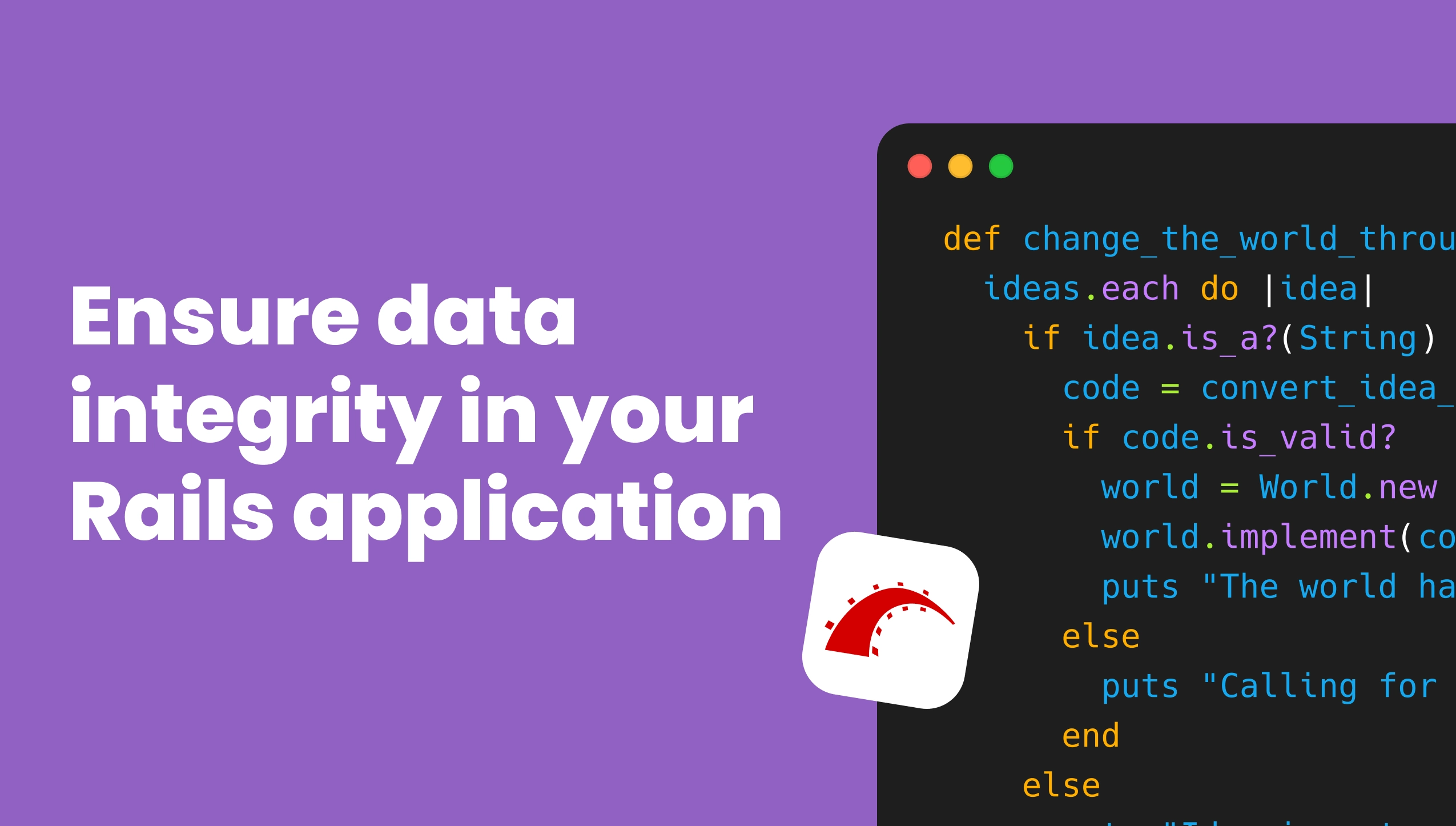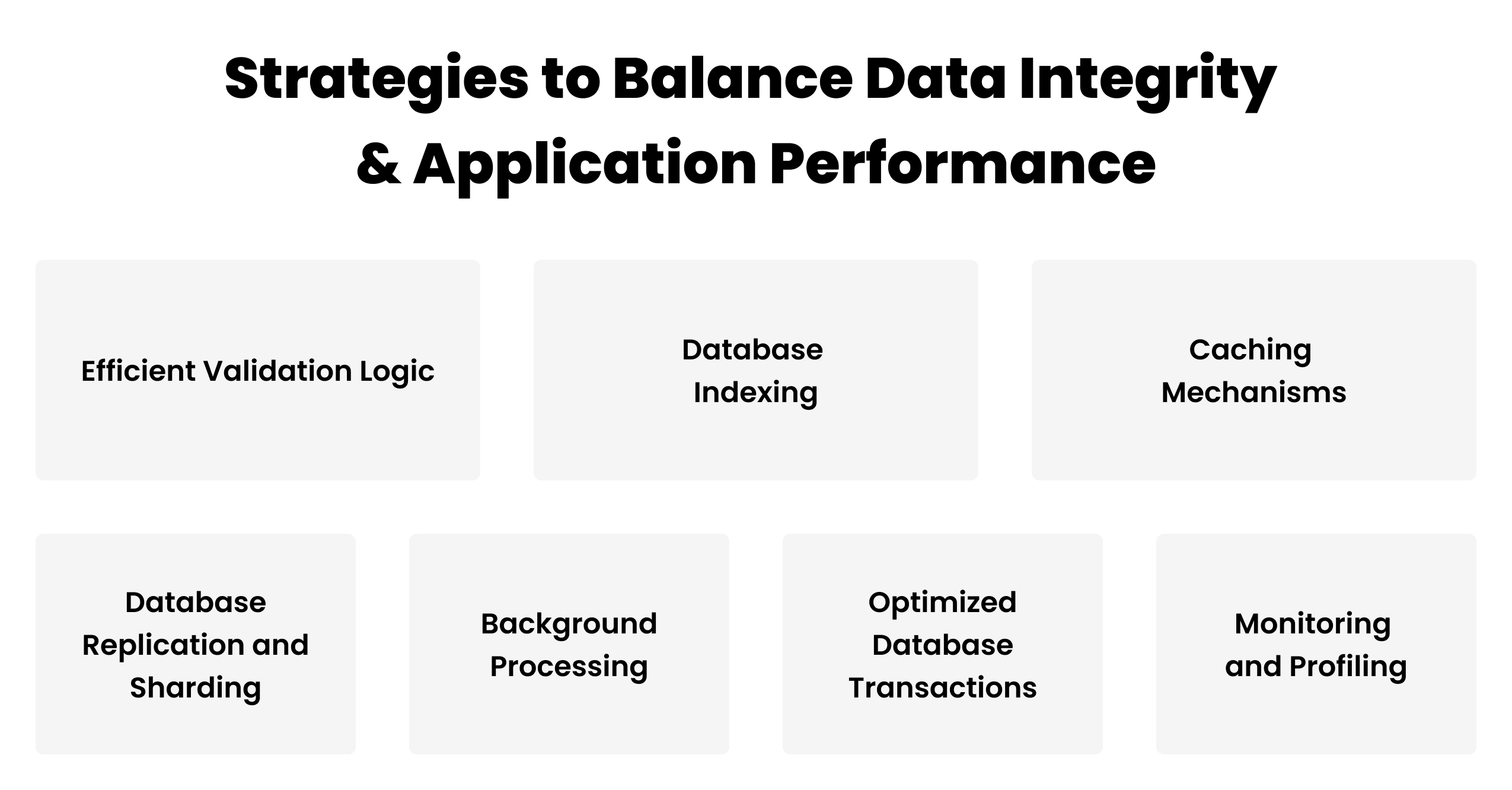Table of Contents
Make sure to read our other Data Integrity related posts:
- Data Integrity – Foundation of Trust
- Ensure Data Integrity in your Rails Application
Data integrity is a crucial aspect of any application, ensuring that information remains accurate, consistent, and reliable throughout its lifecycle. Luckily, Ruby on Rails (Rails) provides comprehensive tools and conventions to support data integrity, including migrations, schema management, validations, transactions, and more.
In Rails, there is a built-in ORM called ActiveRecord, which supports transactions and ensures data integrity. ActiveRecord allows developers to work with database records as if they were Ruby objects, abstracting away the complexities of direct SQL queries. It handles CRUD (Create, Read, Update, Delete) operations and provides a range of methods for querying and manipulating data.
Data Integrity in Rails
Rails supports data integrity through several conventions, configurations, and built-in tools, ensuring that data remains accurate, consistent, and reliable throughout the lifecycle of an application.
Migrations and Schema Management
Rails migrations allow developers to evolve the database schema over time in a controlled manner. Migrations provide a way to add, modify, or remove database tables and columns while keeping the schema in sync with the application code.
Schema validations and constraints can be defined within migrations to enforce data integrity at the database level.
Schema Versioning
Each migration file is assigned a unique timestamp, ensuring that changes are applied in the correct order. Rails maintains a schema version in the schema_migrations table, tracking which migrations have been run. This system of versioning ensures that developers can confidently apply or rollback changes, knowing that the database schema will remain consistent and up-to-date.
Schema Dump
Rails can generate a schema file (db/schema.rb or db/structure.sql)) that represents the current state of the database schema. This file serves as a snapshot of the schema at a given point in time, allowing developers to recreate the database schema without having to run all the migrations from scratch. This is particularly useful for setting up new development environments or ensuring that the production database matches the expected schema.
Validations
ActiveRecord provides a range of built-in validation methods to ensure data integrity before records are saved to the database. These validations can check for the presence, format, uniqueness, and length of data attributes.
Custom validations can also be defined to enforce more complex business rules.
Uniqueness Constraints
The validates_uniqueness_of method in ActiveRecord does not guarantee uniqueness on its own. Instead, it checks for uniqueness at the application level, which can lead to race conditions where duplicates might still be inserted into the database. To ensure true data integrity, it’s essential to always use a unique index at the database level. The unique index is what ultimately enforces uniqueness and prevents duplicate entries. The validation itself is more of a convenience for capturing errors early in the application, but it should never be relied upon as the sole measure for ensuring data uniqueness.
Associations and Foreign Key Constraints
ActiveRecord associations (e.g., belongs_to, has_many, has_one) help define relationships between different models, ensuring referential integrity.
Foreign key constraints must be added to migrations because they are essential for ensuring data integrity. These constraints enforce relationships at the database level, preventing orphaned records and maintaining referential consistency. In Rails, migrations for associations automatically generate foreign keys, which plays a crucial role in upholding data integrity by enforcing these relationships directly within the database.
Transactions ensure that a series of database operations succeeds or fails, maintaining data integrity in complex operations.
By leveraging these conventions, configurations, and built-in tools, Ruby on Rails ensures that applications maintain high data integrity standards, reducing the risk of data anomalies and inconsistencies.
Ensuring Uniqueness in ActiveRecord
Ensuring data uniqueness in ActiveRecord, the ORM layer for Ruby on Rails is a crucial aspect of maintaining data integrity in your applications. Rails provides several mechanisms to enforce uniqueness, primarily through validations and database-level constraints. Below is a detailed exploration of these methods and the considerations involved.
Using Validations
ActiveRecord validations ensure that data conforms to specified rules before it is saved to the database. The validates_uniqueness_of method ensures that the value of an attribute is unique across the system.
This validation checks for the uniqueness of the email attribute before saving the record. However, it is important to note that this validation is performed at the application level and can be bypassed in some race conditions, where multiple processes attempt to create a record with the same attribute simultaneously.
Handling Race Conditions
Race conditions occur when two or more operations are executed concurrently and result in conflicts, potentially compromising data integrity. For instance, two users attempting to sign up with the same email at the same time might pass the uniqueness validation check if it is not enforced at the database level.
Rails addresses race conditions by using database-level constraints and unique indexes. Here’s a clearer breakdown:
- Unique Indexes: At the database level, unique indexes ensure that duplicate records cannot be inserted, even if multiple processes attempt to do so simultaneously.
- Database-level Constraints: These constraints provide additional protection against race conditions by enforcing data integrity rules.
For example, the following migration creates a unique index on the email column, ensuring uniqueness is enforced at the database level:
add_index :users, :email, unique: true
Whether you are just starting with Rails or have been using it for years, understanding and implementing these mechanisms will help you ensure that your application’s data remains trustworthy and consistent.
Testing for Uniqueness
Imagine building a robust Rails application. Your reliable friend in making sure your code works as intended is testing. Which testing framework, though, should you pick?
RSpec and MiniTest are both valuable tools for testing Rails applications. MiniTest is lightweight and simple, making it efficient, while RSpec excels in larger projects with its expressive, BDD-focused approach. The choice between them depends on team preferences and project needs. Testing is an ongoing process, so let’s explore the advanced features of both frameworks.
RSpec emphasizes readable, English-like specifications that describe how the application should work, supporting BDD and providing clear expressions of expected behavior. MiniTest, while simpler, also supports TDD, BDD, and benchmarking, with strong integration into Ruby’s test ecosystem.
Both frameworks share similar testing principles, and expertise in one easily transfers to the other. Minitest offers seamless integration with Ruby’s test runners, various assertion methods, parallel test execution, and syntax similar to RSpec’s. It’s straightforward and familiar to Ruby developers.
RSpec, a BDD tool, encourages collaboration by making tests human-readable, using natural language structures like “describe” and “it.” It provides a wide range of matchers, hooks, configuration options, and integrates with tools like FactoryBot and DatabaseCleaner, making it a powerful choice for Ruby testing.
Impact of Stringent Data Integrity Checks on Rails Application Performance
Maintaining stringent data integrity checks in a Ruby on Rails application significantly impacts performance, leading to increased latency, higher resource consumption, reduced throughput, and potential database locking. By incorporating methods such as refining validation logic, utilizing efficient indexing, making use of caching mechanisms, implementing database replication and sharding, transferring checks to background processing, enhancing transactions, and continuously monitoring and profiling, it becomes feasible to strike a balance between the demand for data integrity and the essential need for high performance.
Data Integrity Checks and Performance Implications
Data integrity checks in a Rails application typically involve a series of validations, constraints, and transactions designed to ensure that the data adheres to specific rules and standards. These checks can occur at multiple levels, including the application level, where Rails validations ensure that data conforms to business rules before it is saved to the database, and the database level, where constraints and triggers enforce data integrity rules directly in the database.
Performance Implications:
- Increased Latency: Each data integrity check requires additional processing time. Complex validations and constraints, especially those involving multiple table joins or computationally intensive operations, can introduce significant latency, slowing down the response time of the application.
- Higher Resource Consumption: Stringent data integrity checks often consume more CPU and memory resources. Each validation rule adds to the computational overhead, which can strain the application server, particularly under high load conditions.
- Reduced Throughput: With the additional processing required for integrity checks, the throughput of the application may decrease. This means that the application can handle fewer requests per unit of time, potentially leading to bottlenecks and reduced scalability.
- Database Locking: When data integrity checks involve transactions, there is a potential for increased database locking. Transactions ensure atomicity, but they can also lock rows or tables, leading to contention and reduced database concurrency
Strategies to Balance Data Integrity and Application Performance
Balancing data integrity and application performance requires a strategic approach that leverages various optimization techniques without compromising the accuracy and reliability of the data. Below are some effective strategies:
Efficient Validation Logic
Optimizing validation logic is essential to minimize the performance overhead associated with data integrity checks.
Strategies include:
- Reducing Complexity: Simplify validation logic to ensure it is as efficient as possible. Avoid redundant validations and combine multiple checks into a single, more efficient operation where feasible.
- Conditional Validations: Use conditional validations to apply checks only when necessary. This can significantly reduce the number of validations performed, particularly in scenarios where certain validations are only relevant under specific conditions.
Database Indexing
Proper indexing can drastically improve the performance of data integrity checks at the database level:
- Index Utilization: Ensure that all columns involved in validations and constraints are appropriately indexed. Indexes can accelerate the lookup of records, reducing the time required for integrity checks.
- Selective Indexing: While indexes can significantly enhance read performance, they may also slow down write operations. To achieve the best balance, it’s essential to index only those columns that are frequently queried or used in filtering. Indexing should focus on the columns most often involved in search conditions, as this will optimize performance without unnecessarily impacting write speeds.
Caching Mechanisms
Implementing caching strategies can mitigate the performance impact of repetitive integrity checks:
- In-Memory Caching: If the data validation logic in your application is particularly resource-intensive, it may be worth considering in-memory caching solutions like Redis or Memcached. These tools can store the results of frequently performed validations, significantly reducing the need to repeatedly execute the same costly validation logic and improving overall performance.
Database Replication and Sharding
Distributing the database load can improve performance while maintaining data integrity:
- Read Replicas: Implementing read replicas can help offload read operations from the master instance, thereby reducing the load on it. By decreasing the number of read requests hitting the primary database, you can improve its overall performance, allowing it to handle write operations and other critical tasks more efficiently. This can lead to better performance for data integrity checks and other operations that rely on reading from the database.
- Sharding: Implement database sharding to partition data across multiple databases. Sharding can distribute the load more evenly and improve the performance of data integrity checks by reducing the amount of data each database node needs to handle.
Background Processing
Offloading certain integrity checks to background jobs can enhance the responsiveness of the application:
- Asynchronous Validations: Perform non-critical validations asynchronously using background processing frameworks like Sidekiq or Resque. This allows the application to remain responsive while ensuring data integrity is maintained in the background.
- Deferred Integrity Checks: For certain types of data, consider deferring the actual database write operations to a later stage when the system is under less load. This approach can help balance immediate performance needs with the requirement for maintaining data accuracy and integrity.
Optimized Database Transactions
Efficient management of database transactions can minimize locking and improve performance:
- Batch Processing: Group multiple integrity checks and database operations into a single transaction where feasible. This reduces the overhead associated with managing multiple transactions and can improve overall performance.
- Transaction Isolation Levels: Adjust the isolation levels of transactions to balance data integrity requirements with performance. For instance, using a lower isolation level like Read Committed can reduce locking overhead while still providing adequate data consistency.
Monitoring and Profiling
Continuous monitoring and profiling are essential to identify and address performance bottlenecks:
- Performance Monitoring Tools: Utilize performance monitoring tools such as New Relic, Datadog, or Skylight to track the impact of data integrity checks on application performance. These tools can provide insights into where optimizations are needed.
- Database Profiling: Regularly profile database queries to identify slow queries related to integrity checks. Use the database’s built-in profiling tools or third-party solutions to optimize these queries.
Adopting these strategies can help in building robust and efficient Rails applications that maintain data accuracy without compromising on speed and responsiveness, thus providing a seamless user experience while ensuring the integrity of the underlying data. Rails’ built-in ORM, ActiveRecord, provides comprehensive tools and conventions to support data integrity through migrations, schema management, validations, uniqueness constraints, associations, foreign key constraints and transactions.
Stay tuned to learn how to optimize your Rails applications with Sidekiq and ensure they run smoothly even under heavy load. In our upcoming article, “Sidekiq: Efficient Background Processing” we will explore how to leverage Sidekiq to handle background jobs in Rails applications efficiently. We will discuss best practices for using Sidekiq, its integration with ActiveRecord, and how it can further enhance the performance and responsiveness of your application by offloading time-consuming tasks to background processes.






